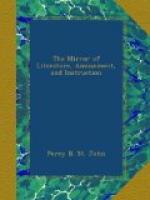In India, the lower orders use a hookah or hubble bubble, which is made of a cocoa-nut shell well cleaned out, having a hole through the soft eye of the shell, and another on the opposite side, a little lower down, the first of which is used for the chauffoir, and the other to suck or draw the smoke from. The shell is nearly filled with water, and a composition of tobacco, sugar, and sometimes a little opium, is put into the chauffoir, in shape of a ball, about the size of a marble, which they call joggery. A live coal is then put on the ball in the chauffoir, and the hubble-bubble is handed from one to another, with the best relish imaginable. Sometimes a dozen natives, get squatting on their hams, in a group, and pass this delicate article of luxury from one to another, each taking two or three good pulls at it as it goes round, and chattering three or four at a time, like so many apes. They likewise emit the smoke through their nostrils like the Chinese. The women are in the habit of enjoying the hubble-bubble, in groups, in a similar manner.
The best Cheroots are manufactured at Chiusmab, near Calcutta, where likewise a great quantity are made up; they vary in length from four to eight or nine inches. A great quantity are likewise manufactured at Masulapatam, but they are considered as much inferior to those of Bengal. At Masulapatam there is a very extensive manufactory of a black clammy snuff, which is sent all over Hindostan.
Camden Town.
R.L.
* * * * *
STORY OF A BOY.
(For the Mirror.)
Some years back a small party of children were amusing themselves upon the beach, near the town of Conway, in North Wales. One of them a fine boy of three years old being much fatigued, left his juvenile companions, and unperceived by them, got into a boat not far from the spot, and fell asleep. The tide soon afterwards coming in, floated the boat, and carried it up the river; and upon the return of tide it fell back, and subsequently the boat and infant were carried out into the channel, between Puffin Isle, near the Anglesea Coast and the Lancashire Shore, or I should say, in the Irish Channel. A trading vessel, in the grey of the morning, perceiving a small boat so far from any land, bore down, and the crew to their great surprise, found only the poor child in it, nearly heart broken at its unfortunate situation, and totally unable to give any regular account of itself. The master of the vessel felt every wish and anxiety to restore the poor child to its parents, but not being able to glean from it who they were, and having no children of his own, he made up his mind to adopt the boy, congratulating himself that Providence had in this singular manner thought proper to send him an heir to his property, and a delight as he fondly hoped in his declining years. Accordingly after his return back from Liverpool, where he was then bound, to his residence in the North of Ireland, he introduced his little charge to his wife, who had never borne him any family; related the very singular manner he had found him, and they mutually agreed to take him under their protection until they could find out his parents, and if they were unsuccessful, to bring him up as their own child.




